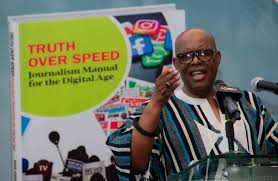Journalism in the age of the ‘bot’: A review of ‘truth over speed’
These apps can equip the artificially-generated images with speech facilities that are purloined from elsewhere on the internet. So when one sees the
- Advertisement -
The digital age is a very dangerous one. The Internet is replete with “apps” that can create robotic versions of actual human beings.
These apps can equip the artificially-generated images with speech facilities that are purloined from elsewhere on the internet. So when one sees the
- Advertisement -
robotic or counterfeit individual (or so-called “bot”) on the screen, its speech, mannerisms and even topics of choice, resemble those of the victim of the ruse.
- Advertisement -
Indeed, so expertly executed are these camouflaged efforts these days that I wouldn’t be surprised if someone put ‘President Joe Biden’ on the air, congratulating the shooter who nearly assassinated former President Donald Trump at the weekend.
Now, the really horrible aspect of this development is that it is so easy for an artificially-generated “item” to be disseminated around the world in just a matter of minutes. Gullible people would accept such an item as genuine, and even those who are a bit more sceptical might have to think twice before saying, “No – this can’t be right!”
In Ghana, items of this nature that are produced in local languages are quite
easily believed. Indeed, every now and then, “debates” or “discussions” generated by such items take place without anyone pausing to ask whether the production was true or not! Especially if the “villain” happens to be someone whose antics and statements tend to rub his or her rivals the wrong way.
Thus, the appearance of a book written by Nana Kwasi Gyan-Apenteng, former chair of the Ghana National Media Commission, with a clear title that warns that there should be a preference for “TRUTH OVER SPEED”, is most opportune. In other words, journalists, for whom the book was written as a “Manual for the Digital Age”, can no longer offer as an excuse for any inaccuracies they pass on to the pubic: “We didn’t know it was untrue; moreover, we didn’t have the time to cross-check the facts”.
- Advertisement -
As usual, the printing is faultless, just like all the other publications with which the inimitable Fred Labi (Managing Director/owner) has been filling the empty bookshelves of Ghanaias who love reading.
The book’s author, Nana Gyan-Apenteng, has assiduously covered most of the subjects which can help the journalist to be cautious and not fall into the trap of preferring Speed over Truth. He begins with a philosophical look at the requirements of the “digital age”. He then plunges into “The Media Landscape in Africa (An Overview)” and then goes on to dissect the journalistic world with 36 chapters based on sessions of a major discourse of journalism which he conducted all over Ghana with the kind support of the MTN Communication team, led by Georgina Asare Fiagbenu.
MTN’s Senior Vice-President (MTN GROUP MARKETS) contributed a “foreword to the book in which he said: “We understand that the pressure to deliver news quickly can sometimes compromise accuracy and integrity in today’s fast-paced world.
However, this manual prioritises truth over speed, encouraging journalists to verify information before disseminating it.”
MTN should be congratulated on recognising that its provision of first-rate technology to developing countries like Ghana that enables them to operate in the same “real time” as the developed countries, tacitly poses a moral duty on it to scrutinise the way that technology is used by – especially – media functionaries.
Source:ghanaiantimes.com
- Advertisement -


